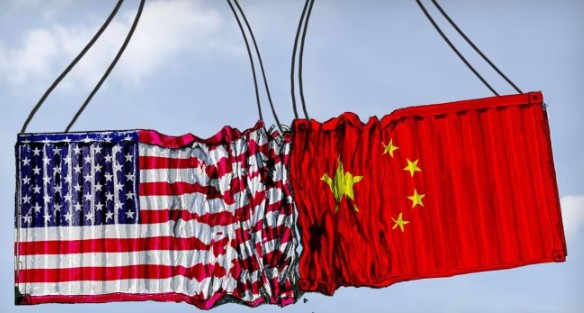The Shockwave: What Happened on October 10
On October 10, President Donald Trump issued a sweeping threat to impose a “massive increase of Tariffs on Chinese products,” citing retaliation for China’s newly announced export controls on rare earth minerals. These minerals are essential to the production of semiconductors, electric vehicles (EVs), renewable energy systems, and advanced defense technologies. The announcement came via a lengthy post on Truth Social and was accompanied by the cancellation of a planned diplomatic meeting with Chinese President Xi Jinping at the upcoming APEC summit in South Korea. Trump described China’s actions as “very hostile,” accusing Beijing of attempting to “hold the world captive” through its control of rare earths and related technologies.
The market reaction was swift and severe. The S&P 500 dropped 2.71%, the Dow Jones Industrial Average fell by 878 points, and the Nasdaq Composite slid 3.58% by the close of trading. Cryptocurrency markets shed over $125 billion in value, with Bitcoin and Ethereum leading the decline. Gold surged past $2,000 per ounce as investors sought safe havens, while oil prices dipped amid fears of global demand contraction. The CBOE Volatility Index (VIX) spiked above 30, signaling heightened investor anxiety and a turbulent quarter ahead.
This marks a dramatic reversal from the relative calm of the summer, when tariffs had stabilized around 30% following a temporary truce. Trump’s new threat could push rates back toward the 145% peak seen during the height of the 2018–2020 trade war. With rare earths now at the center of the dispute, the implications for global supply chains and geopolitical stability are profound.
Strategic Analysis: What’s Really at Stake
This escalation is not merely a political maneuver it represents a strategic rupture in the global trade architecture. China’s rare earth restrictions are a calculated move to exert pressure on U.S. technology and defense sectors, leveraging its near-monopoly on critical minerals. The new rules, announced by China’s Ministry of Commerce, require export licenses for any product containing more than 0.1% rare earths or manufactured using Chinese refining or magnet-making technology even if the final product is assembled outside China.
This effectively weaponizes China’s dominance in rare earth processing and creates a chokepoint for global supply chains. Rare earths are indispensable to the production of semiconductors, EV batteries, wind turbines, jet engines, and precision-guided weapons. China produces over 90% of the world’s processed rare earths and 95% of rare earth magnets, making its export controls a direct threat to technological sovereignty and industrial continuity.
Trump’s response threatening a massive tariff hike and canceling diplomatic talks signals a renewed willingness to use economic tools as instruments of geopolitical leverage. The implications are far-reaching. U.S.-listed Chinese companies such as Alibaba, JD.com, and PDD Holdings saw stock declines between 3.9% and 6.7%, while the Philadelphia Semiconductor Index dropped 3.7%, with Qualcomm falling 4.5% amid a separate Chinese antitrust probe. These moves reflect not just market volatility, but a recalibration of risk across sectors dependent on Chinese inputs. For trade professionals and business leaders, this is a moment to reassess exposure, revisit contingency plans, and prepare for a more fragmented and protectionist global landscape.
Strategic Guidance for Business Leaders
For business leaders, this moment demands more than reactive measures it calls for strategic foresight, operational resilience, and forensic-level planning. The playbook from the previous trade war is once again relevant, but the stakes are higher and the global supply chain more fragile. Firms must act decisively to protect margins, maintain compliance, and preserve continuity in the face of escalating trade tensions.
Begin with a comprehensive scenario planning exercise. Map out tariff exposure across product lines, especially those with Chinese-origin components or assemblies. Revisit HS code classifications and ensure they are defensible under scrutiny. Misclassification can lead to penalties, missed refund opportunities, or exposure to higher duty rates under the new regime. Conduct a country-of-origin audit to validate COO documentation and ensure eligibility for preferential treatment under agreements like USMCA.
Assess your rare earth dependency. If your supply chain touches semiconductors, EVs, aerospace, or defense, you may be exposed to disruptions stemming from China’s export controls. Consider alternative sourcing strategies, including domestic suppliers or allied trade partners with stable regulatory frameworks. Engage with trade advisors to explore tariff engineering options, such as reclassification or component substitution, to reduce duty exposure.
This is also a prime moment for client advisory outreach. Issue a bulletin titled “Trade Shock Resilience: October 2025 Outlook,” offering actionable steps for importers and manufacturers. Include a checklist covering tariff refund eligibility, COO validation, risk mitigation strategies, and audit readiness. Position your firm as a proactive navigator in turbulent waters, capable of turning complexity into clarity.
Impact on U.S. Small and Medium-Sized Businesses (SMEs)
Small and medium-sized enterprises (SMEs) are particularly vulnerable to tariff shocks. Unlike large multinationals, SMEs often lack the scale, capital reserves, and supply chain flexibility to absorb sudden cost increases or pivot sourcing strategies quickly. Many rely on Chinese imports for components, packaging, or finished goods, and a sharp tariff hike could erode margins, disrupt inventory planning, and force price hikes that alienate customers.
For SMEs in manufacturing, retail, and consumer electronics, the risk is especially acute. Those with limited supplier diversity may face delays or shortages, while others may struggle with compliance documentation or tariff classification errors. These challenges can result in customs delays, unexpected duty payments, or even reputational damage if customers experience product shortages or price volatility.
To mitigate these risks, SMEs should engage trade advisors to review their import profiles, explore tariff engineering options, and consider nearshoring or reshoring strategies. Government programs like the SBA’s STEP grants or Export Express loans may offer financial support for compliance upgrades or supplier transitions. Operationally, SMEs should build scalable workflows that can adapt to tariff changes, including automated reconciliation systems, duty tracking tools, and audit-ready documentation protocols.
Real-world data underscores the urgency: in 2022, over 70% of U.S. SMEs reported sourcing at least one critical component from China. The SBA’s STEP grant program has seen a 40% increase in applications since the last tariff escalation. Meanwhile, the University of Michigan’s consumer sentiment index dropped to 55 in October, reflecting economic anxiety that will trickle down to SME sales and cash flow.
Impact on U.S. Consumers
Consumers will inevitably feel the ripple effects of this tariff escalation, both in terms of price and availability. Tariffs on Chinese goods typically hit categories like electronics, apparel, furniture, and household items areas where substitution is limited and price sensitivity is high. As retailers pass increased costs along to consumers, expect to see inflationary pressure on everyday goods, especially during the holiday season when demand peaks and inventory cycles tighten.
Supply chain disruptions could also lead to stockouts or delayed shipments, frustrating shoppers and straining customer service operations. In sectors like automotive and tech, rare earth restrictions could slow production or raise prices on EVs, smartphones, and smart appliances. Consumers may respond by delaying purchases, shifting to lower-cost alternatives, or reducing discretionary spending reshaping demand curves and forcing retailers to recalibrate pricing strategies.
Politically, this could reignite debates around trade policy, inflation, and economic resilience especially as election season heats up. The NASDAQ Composite fell 3.58% on October 10, with tech stocks leading the decline. Trump’s tariff threat comes amid rising inflation concerns and federal layoffs triggered by government shutdown impacts, compounding consumer anxiety and economic fragility.
How Peacock Tariff Consulting Can Help
This is a textbook moment for forensic-level advisory. At Peacock Tariff Consulting, we specialize in turning regulatory volatility into operational clarity. Our services are designed to help SMEs and cross-border operators build resilient, compliant, and scalable trade frameworks that withstand shocks and support growth.
We offer:
- HS Code Reviews: Ensure your classifications are defensible and optimized for duty savings.
- COO Validation: Strengthen your documentation to withstand audits and qualify for USMCA benefits.
- Client-Facing Bulletins: We’ll help you craft trade shock advisories tailored to your industry and audience.
- SME Resilience Planning: Build scalable, compliant workflows that protect your margins and mitigate risk.
Did You Know?
China produces 95% of the world’s rare earth magnets used in everything from jet engines to MRI machines. A single misclassified component could trigger a 100% tariff under the new regime. Our team helps ensure that doesn’t happen to you.
Conclusion: Turning Shock into Strategy
The October 2025 tariff escalation is more than a headline it’s a strategic tremor that will reshape trade flows, supply chains, and consumer behavior for months, if not years, to come. For small and medium-sized enterprises, the challenge is not merely survival it is transformation. This moment demands a shift from reactive firefighting to proactive resilience-building. Businesses must not only adapt to the immediate threat of rising costs and disrupted supply chains but also prepare for a future where trade policy is increasingly volatile, politicized, and weaponized.
The firms that will thrive are those that treat this disruption as a catalyst for operational maturity. That means investing in forensic-level documentation, building defensible workflows, and embedding compliance into every layer of the organization from procurement to invoicing to executive strategy. It means understanding that HS codes are not just technical labels but strategic levers; that COO declarations are not just paperwork but shields against regulatory risk; and that tariff engineering is not just a cost-saving tactic but a competitive advantage.
Moreover, this moment calls for leadership. SMEs must communicate clearly with clients, suppliers, and regulators. They must educate their teams on the implications of trade shocks and empower them to respond with agility and confidence. They must engage with advisors who understand not just the letter of the law but the spirit of strategic adaptation. And they must recognize that resilience is not built in isolation it is forged through collaboration, foresight, and a commitment to excellence.
At Peacock Tariff Consulting, we believe that complexity is an opportunity in disguise. Whether you’re a manufacturer navigating rare earth exposure, a retailer recalibrating your pricing strategy, or a service provider advising clients through uncertainty, our mission is to turn regulatory volatility into operational clarity. We help you build the frameworks, advisories, and workflows that protect your business and empower your growth. Because in trade, resilience isn’t just a strategy it’s a legacy. And in moments like these, legacy is built one decision at a time.
#TradeShock2025 #RareEarthCrisis #SMEResilience #TariffStrategy #SupplyChainRisk #USChinaTrade #PeacockTariffConsulting

